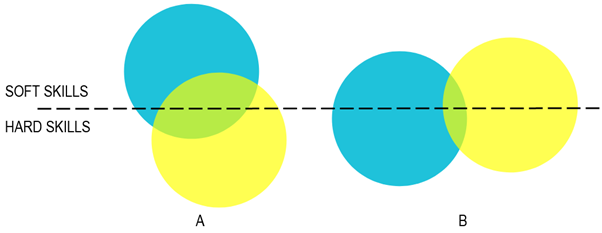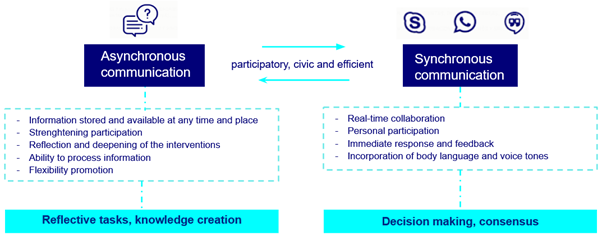3.3 INTERACTION - NETWORKED COMMUNITY
Each and every one of the parties involved in the VET must participate, to a greater or lesser degree, in all parts of the process so that all of them can achieve their objectives in the best possible way.
When the students start their practices in a company, the previous learning is activated in a specific workplace. Good practice should be able to adapt the general aspects of the educational process to a particular context.
What I also see is the wish to, when you approach something in the company, in the sense of work-based competence development, you would like to link it to the study process or the curricula. It is not so easy, also because practice and theory phases are different between study programmes, but this is something I perceive from the conceptional position (DHBW Entrepreneur). |
Should the training be based on the needs of the company, the employer or the needs of students?… I have to create a balanced combination of the interests of the students and the interests of the company or the economy (HP Entrepreneur). |
Without forgetting that VET practices are part of the students’ educational process:
It is important to be aware of the role of the school as an educational institution. We have to promote education, the development of our students as responsible citizens, and look after to all the aspects of any person development in society. (UOC Teacher) |
So, each network needs to find its own balance to transform possible tensions between particular interests or points of view into new inputs to enrich all the participants with the proposed practice and its performance. The elements to be analyzed by the network involved could be:
3.3.1. SKILLS DETECTION AND INTEGRATION
If we focus on the skills, the figure XXX shows three differentiated areas:
The blue zone: those skills that are enhanced/addressed at a VET institution but that are not activated in a specific workplace.
The yellow zone: are those skills that are enhanced/addressed at a VET institution but that are not activated in a specific workplace.
The green zone: are those skills that are worked on in both sites.
The network coordination of those involved must allow the detection of the three different areas.

The figure XXX shows two examples that we can find in a practice:
Figure XXXA shows a situation where many soft skills have been worked in a school, but few of the hard skills needed in the workplace.
Figure B shows a school and a practice where both types of skills are worked in a balanced way, but they are very different in both places.
A and B show two situations where it is necessary to coordinate efforts to allow a better integration of the training needs in practice.

- The analyzed practice allows the detection of soft and hard skills involved in a workplace, and promotes the best integration of them through the network coordination
3.3.2. WORKPLACE DIGITALIZACION STATE
Another important aspect in which we can apply the same analysis shown by the previous figures is the state of digitalization of a company or a VET institution.
Stakeholders have revealed how in many companies manual work or personal interaction is essential, which could keep them away from a model based on digitalization:
On the other hand, I am very skeptical that the practical part of the company can hardly be communicated digitally, at least in the trades. The practical skills, which I have to learn in the company, that is not digital (HP Entrepreneur). |
In the building trades this is terribly difficult to do in trades where they sit behind a desk it is much easier because think of a painter or a carpenter when they are up on the roof or up on the scaffolding then they can’t even go up in glasses and then I could go on and on about these things unfortunately, unfortunately not everywhere (IPOSZ Entrepreneur). |
- The digital aspects of the analyzed practice are well developed in the workplace.
3.3.3. MENTORING AND COMMUNICATION
Successful interaction between the parties involved requires communication planning for each stage of the process: moments, topics, and tools of communication are some of the most important elements of the communication plan.
– Very important is the interaction in the design phase and the digitized interaction with the business manager in the evaluation phase. – What is important, in my opinion, is to govern the interaction of communication. if you don’t create interaction or community you should not assume that it won’t create itself. – It is good to structure communication for the purpose of measuring progress…Communication supports the engagement of the pupils and their psychological security. (CIS Teachers) |
Both types of communication, synchronous and asynchronous, should be integrated in the communication plan. The following image shows the principal characteristics of each of them:

Taking into account these characteristics, a good D-WBL practice should define moments, participants, topics and type of communication during the practice development. For example, it is very useful to have a synchronous meeting at the beginning of the practice to clarify any question and to generate a positive work environment.
All people involved must ensure that all they understand the concept and the importance of relationships. Training and awareness workshops can facilitate this. An important factor in all this is that while the internal training workshops will educate people within an organisation, a fully integrated approach would require cross-organisational workshops (PANKO Entrepreneur). |
The figure of a mentor is also an important element to ensure the good coordination and collaboration between all the people and institutions involved. A mentor guides the student when necessary and is the cornerstone of the collaborative development of a good practice.
The knowledge that the trainee comes with may not be the same as the knowledge that is likely to be needed to solve a particular programme. But that’s what a mentor is for. And we have mentors and at some point not one mentor but two (IPOSZ Administration). |
The analyzed practice includes a communication plan and a mentor, both of them focused on the collaborative development of the practice.
